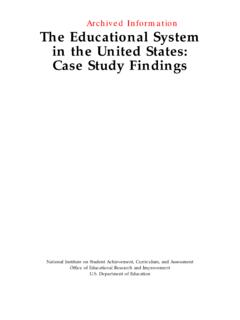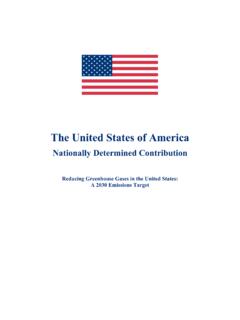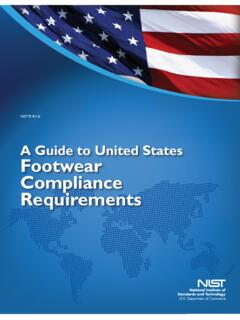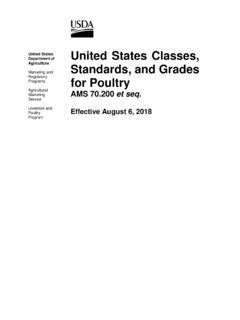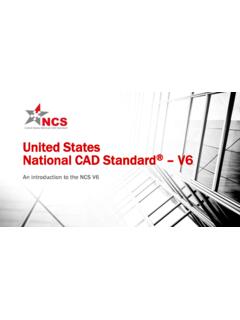Transcription of An Overview of Accreditation of Higher Education in the …
1 An Overview of Accreditation of Higher Education in the united states Updated October 16, 2020. Congressional Research Service R43826. SUMMARY. R43826. An Overview of Accreditation of Higher October 16, 2020. Education in the united states Alexandra Hegji The federal government provides varying types of support to postsecondary students and schools, Analyst in Social Policy including student financial assistance ( , Pell Grants and Direct Loans) authorized under Title IV of the Higher Education Act (HEA). Postsecondary schools seeking to participate in these federal programs must meet a variety of requirements, including being accredited by an agency recognized by the Department of Education (ED) as a reliable authority on the quality of the Education being offered.
2 The united states does not have a centralized authority exercising singular national control over postsecondary educational institutions. Consequently, the character and quality of postsecondary s chools and their programs can vary widely. The role of Accreditation in Higher Education is to serve as a marker of a level of acceptable quality across the wide array of postsecondary schools and educational programs. The federal government has come to rely on accrediting agencies recognized by ED to help ensure the postsecondary institutions and educational programs to which federal funds are provided meet a minimum quality level.
3 Higher Education practitioners and stakeholders refer to three general types of accrediting agencies, each of which serves a specific purpose. Regional accrediting agencies concentrate their reviews on institutions in specific regions of the united states . National accrediting agencies operate across the united states and primarily review proprietary institutions, career- based single-purpose institutions, and religiously affiliated institutions. Programmatic accrediting agencies operate nationwide and review individual educational programs and single-purpose institutions.
4 ED refers to the different accreditors as institutional accreditors, which evaluate entire postsecondary schools and comprise regional and national accreditors, and programmatic accreditors. The Accreditation process is voluntary and educational institutions or programs must request it. While ED-recognized accrediting agencies' review processes are guided in part by federal requirements, specific procedures for reviews are adopted by the individual agencies and vary among them. In general, however, the review proce ss begins with an institutional self-assessment, and is followed by an institutional review by an outside team of peers primarily composed of Higher Education faculty and practitioners, submission of a comprehensive report by the team to the accrediting agency, the agency's Accreditation determination, and regular subsequent reviews of accredited institutions.
5 Although the federal government relies on accrediting agencies to evaluate the quality of Education offered at postsecondary schools, the HEA and ED regulations specify a variety of requirements that accrediting agencies must meet to be recognized by ED. Key provisions require that accrediting agencies consistently apply and enforce standards that ensure the Education programs offered are of sufficient quality to meet the stated objective for which they are offered;. use review standards that assess student achievement in relation to the institution's mission, including, as applicable, course completion, passage of state licensing examinations, and job p lacement rates.
6 Evaluate, among other considerations, an institution's or program's curricula, faculty, facilities, and fiscal and administrative capacity; and meet required operating and due process procedures with respect to the institutions and programs they accredit. Congressional Research Service An Overview of Accreditation of Higher Education in the united states Contents Introduction .. 1. Historical Role of Accreditation in Higher Education .. 1. Purpose of Accreditation in Higher Education .. 2. Accrediting 2. Institutional 3.
7 Regional Accrediting Agencies .. 3. National Accrediting Agencies .. 3. Programmatic Accrediting Agencies .. 4. The Accreditation Process .. 4. Funding .. 4. Evaluations and Review Procedures .. 5. The Federal Role in 6. Evolution of the Federal Role in Accreditation .. 6. Early Federal Recognition .. 7. Higher Education Act of 1965 .. 7. Expansion of Federal Recognition 7. 2019 Regulations .. 8. Role of the Department of Education in Accreditation .. 9. Recognized Accrediting Agencies .. 9. Current Recognition 10.
8 Process for Recognition of Accrediting 14. National Advisory Committee on Institutional Quality and Integrity (NACIQI) .. 15. Functions .. 15. Membership .. 16. Contacts Author Information .. 16. Congressional Research Service An Overview of Accreditation of Higher Education in the united states Introduction The federal government provides varying types of support to postsecondary students and schools. Title IV of the Higher Education Act of 1965 (HEA; 89-329), as amended, authorizes the primary programs that provide financial assistance ( , Pell Grants and Direct Loans) to students to assist them in obtaining a postsecondary Education at eligible institutions of Higher Education (IHEs).
9 In academic year (AY) 2017-2018, 6,642 IHEs were eligible to participate in the Title IV. student aid programs. 1 Approximately $ billion was made available to students through Title IV student aid in FY2018. 2 Thus, the federal government has an interest in ensuring the quality and integrity of postsecondary Education in general, and of postsecondary Education provided by IHEs in particular. However, federal law makes clear that ED shall not exercise control over educational curriculum. 3 As such, the HEA sets forth three requirements known as the program integrity triad that IHEs must meet to participate in the Title IV programs.
10 The three requirements are state authorization, certification by ED, and Accreditation by an accrediting agency or association (hereafter referred to as an accrediting agency) recognized by ED. 4 The program integrity triad is intended to provide a balance in the Title IV eligibility requirements. The states ' role is consumer protection, the federal government's role is oversight of compliance to ensure administrative and fiscal integrity of Title IV programs at IHEs, and the accrediting agencies' role is to provide quality assurance of the Education or training offered by IHEs.











